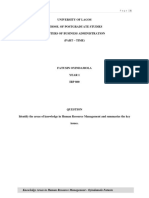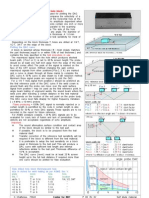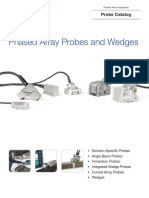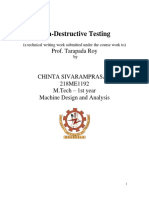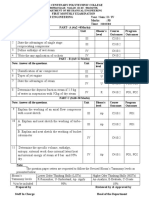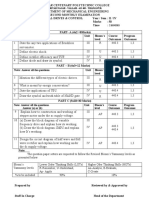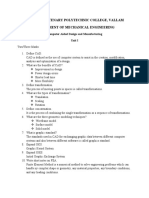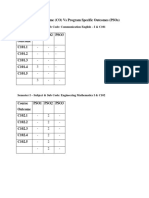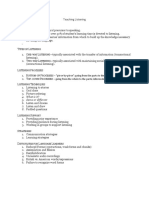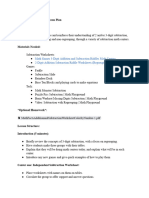6dB Sizing
6dB Sizing
Uploaded by
Jeevanandam ShanmugasundaramCopyright:
Available Formats
6dB Sizing
6dB Sizing
Uploaded by
Jeevanandam ShanmugasundaramOriginal Description:
Copyright
Available Formats
Share this document
Did you find this document useful?
Is this content inappropriate?
Copyright:
Available Formats
6dB Sizing
6dB Sizing
Uploaded by
Jeevanandam ShanmugasundaramCopyright:
Available Formats
Half amplitude / 6 dB drop technique : Half amplitude technique for defining the ends of a discontinuity is used when it is longer
than the crystal size of the probe. This is the most popular technique for discontinuity length measurement. After maximizing the discontinuity indication, set this signal to a convenient height [ ~ 80 % ]. The probe is then moved towards right, parallel to the discontinuity or the weld seam as appropriate, up to the position where the signal drops to half the set amplitude. A point is marked with a marker above the discontinuity location corresponding to the centerline of the probe crystal. A similar point is found by moving the probe towards the left. The distance between these two points is the length of the discontinuity. The discontinuity length measured by this technique always results in an over estimation of the actual size. This is because the half intensity line is located at an angle to the main axis of the beam [ centerline of the crystal ]. The error will depend on the size and frequency of the probe and the beam path distance to the discontinuity. The shape at the ends of the discontinuity will also influence the measurement. Small crystal probes [ 4 MHz, 8 X 9, 10 mm ] should be preferred for the measurements. This measurement error can be minimized by plotting the half amplitude beam boundary in the horizontal plane using the IOW beam profile block and using the graph thus obtained for correcting the length at the applicable flaw depth. Edge approach technique : When the discontinuity size is much smaller than the size of the crystal, half amplitude technique of measurement does not produce satisfactory result. A different method called edge approach technique is used. Compiled by K. Chatterjee, 75643 Center for NDT
In this method the edge of the ultrasound beam is used to find the starting edge of the discontinuity. Once the presence of the discontinuity is confirmed, the scanning starts from a position where the discontinuity signal is not visible on the CRT screen. The probe is now slowly moved towards the discontinuity up to the position where the discontinuity indication just begins to appear on the CRT screen. A point above the discontinuity location is marked which coincides with the line passing through the sidewall of the probe, facing the discontinuity. A similar point is to be found by scanning the discontinuity by probe movement from the other end. The distance between these two points is the length of the discontinuity.
P 00 Rv 05
Self study material.
You might also like
- Expedia Travel Confirmation - 12 Dec - (Itinerary # 133540733412) PDFDocument1 pageExpedia Travel Confirmation - 12 Dec - (Itinerary # 133540733412) PDFAgeum Lagirdam Poj100% (1)
- Three Knowledge Areas in Human Resource ManagementDocument14 pagesThree Knowledge Areas in Human Resource ManagementOyindamola Fatusin80% (5)
- Basic Principles of Eddy Current InspectionDocument58 pagesBasic Principles of Eddy Current Inspectiondavid eduardo arteaga faubla100% (1)
- Ect MAD 8D Calibration Procedure: Using The Vertical Volts MethodDocument7 pagesEct MAD 8D Calibration Procedure: Using The Vertical Volts MethodShanmukhaTeliNo ratings yet
- Refrigerant Charging Procedure For Air Conditioner or Heat Pump Repair or Refrigeration Equipment RepairDocument10 pagesRefrigerant Charging Procedure For Air Conditioner or Heat Pump Repair or Refrigeration Equipment RepairJeevanandam ShanmugasundaramNo ratings yet
- Ultrasonics Examination Part 3Document3 pagesUltrasonics Examination Part 3JlkKumarNo ratings yet
- Pirt NDT MT Formulae 12aDocument4 pagesPirt NDT MT Formulae 12ashabbir626No ratings yet
- Pipe Inspection With DRDocument10 pagesPipe Inspection With DRPeterNo ratings yet
- Ut Tky ProcedureDocument26 pagesUt Tky ProcedureguruNo ratings yet
- Home Education Resources NDT Course Material Ultrasound: Calibration MethodsDocument7 pagesHome Education Resources NDT Course Material Ultrasound: Calibration MethodspanduranganraghuramaNo ratings yet
- Pana USDocument52 pagesPana USflorin100% (1)
- High Temperature Ultrasonic ScanningDocument7 pagesHigh Temperature Ultrasonic ScanningscribdmustaphaNo ratings yet
- PAUT CalibrationDocument10 pagesPAUT Calibrationfikril shaharudinNo ratings yet
- Ultrasonic Test Procedure1Document8 pagesUltrasonic Test Procedure1MHDNo ratings yet
- Omniscan Setup - Basic SetupDocument29 pagesOmniscan Setup - Basic SetupVictor Antonio Diaz FaundezNo ratings yet
- Angle DACDocument1 pageAngle DACJeevanandam ShanmugasundaramNo ratings yet
- Aptest-PPT (1) HELIUM LEAK TESTDocument16 pagesAptest-PPT (1) HELIUM LEAK TESTSiva ShankarNo ratings yet
- QZ EqDocument6 pagesQZ Eqgalati12345100% (1)
- Tube Probe Selection OlympusDocument12 pagesTube Probe Selection OlympusTechnical A-Star Testing & Inspection MalaysiaNo ratings yet
- Ut PDFDocument88 pagesUt PDFphillipskincaid100% (1)
- Level IiiDocument3 pagesLevel IiiMangalraj MadasamyNo ratings yet
- AGR Field Operations TD Focus-Scan Data SheetDocument2 pagesAGR Field Operations TD Focus-Scan Data SheetJeganeswaranNo ratings yet
- Phased Array Probes and Wedges: Probe CatalogDocument3 pagesPhased Array Probes and Wedges: Probe CatalogDavidMontillaNo ratings yet
- How To Calculate AWS D1.1 Indication Rating - LinkedInDocument6 pagesHow To Calculate AWS D1.1 Indication Rating - LinkedInAhmed LepdaNo ratings yet
- UT Shearwave Level II Indication Plotting ExerciseDocument8 pagesUT Shearwave Level II Indication Plotting ExercisekatycwiNo ratings yet
- Non-Destructive Testing: Prof. Tarapada RoyDocument12 pagesNon-Destructive Testing: Prof. Tarapada RoySIVARAM PRASADNo ratings yet
- PA Probe Catalog en 201304Document24 pagesPA Probe Catalog en 201304Durgamadhaba Mishra100% (2)
- PA Caracterization BlockDocument2 pagesPA Caracterization BlockMuallim MursyidNo ratings yet
- PCN UT Course in Trichy, PCN RTFI Training in Trichy, PCN PT, MT, Eddy Current Courses in Trichy - TIWDocument4 pagesPCN UT Course in Trichy, PCN RTFI Training in Trichy, PCN PT, MT, Eddy Current Courses in Trichy - TIWagniva datta100% (2)
- 8.1 UT Lecture-Defect Sizing and EvaluationDocument24 pages8.1 UT Lecture-Defect Sizing and EvaluationNikhil KashyapNo ratings yet
- LRPDF-Applus RTD Catalogus Probe DepartmentDocument28 pagesLRPDF-Applus RTD Catalogus Probe DepartmentDhanasekaran RNo ratings yet
- UT LEVEL-2 Part-1Document68 pagesUT LEVEL-2 Part-1கோகுல் இராNo ratings yet
- RT Lesson 1 - Review Questions - Introduction To Radiographic TestingDocument1 pageRT Lesson 1 - Review Questions - Introduction To Radiographic Testingابو المعالي الهمامNo ratings yet
- UTDocument88 pagesUTEzhil Vendhan Palanisamy100% (2)
- Visual Inspection ModulesDocument6 pagesVisual Inspection ModulesAgustine Setiawan100% (3)
- Notch DacDocument1 pageNotch DacRaje Guna100% (2)
- PCN General RulesDocument25 pagesPCN General RulesSangeeth Kavil PNo ratings yet
- 11 IRIS Application GuideDocument40 pages11 IRIS Application GuideSuleman JahangirNo ratings yet
- First Name Last Name : LPF Stands ForDocument35 pagesFirst Name Last Name : LPF Stands ForVicky SinghNo ratings yet
- DGS DiagramDocument3 pagesDGS DiagramDhanasekaran R100% (1)
- Probe Placement For Several Weld ConfigurationDocument66 pagesProbe Placement For Several Weld ConfigurationvcpNo ratings yet
- Ultrasonic Testing ProcedureDocument4 pagesUltrasonic Testing ProcedureAradea Permana100% (1)
- U.T ProcedureDocument10 pagesU.T ProceduretreyX67No ratings yet
- Ultrasonic Testing Module 3Document6 pagesUltrasonic Testing Module 3mujjamilNo ratings yet
- Electromagnetic Testing-EMT-ACFM Chapter 10b-LibreDocument237 pagesElectromagnetic Testing-EMT-ACFM Chapter 10b-Libresafeer ahmad100% (1)
- 4.omniscan Setup - Min-Wheel Encoder SetupDocument13 pages4.omniscan Setup - Min-Wheel Encoder SetupcarlosNo ratings yet
- Magnetic Particle New 2Document350 pagesMagnetic Particle New 2DanielNo ratings yet
- Magnetic Particle Testing: ASME BPVC Section V - Article 7 ASTM E-709, E-1444Document50 pagesMagnetic Particle Testing: ASME BPVC Section V - Article 7 ASTM E-709, E-1444hariNo ratings yet
- Advanced Ultrasonic Techniques For Nondestructive Testing of Austenitic and Dissimilar Welds in Nuclear FacilitiesDocument10 pagesAdvanced Ultrasonic Techniques For Nondestructive Testing of Austenitic and Dissimilar Welds in Nuclear FacilitiesAnonymous 5qPKvmuTWCNo ratings yet
- Jireh Circ It ScannerDocument2 pagesJireh Circ It ScannerMarcos Kaian Moraes RodriguesNo ratings yet
- Pitch-Catch CalcDocument1 pagePitch-Catch CalcLalit MisraNo ratings yet
- Eddy Current Inspection: UNIT-5Document65 pagesEddy Current Inspection: UNIT-5Pratap KumarNo ratings yet
- Tank TOFD-Presentation PDFDocument31 pagesTank TOFD-Presentation PDFJavierfox98100% (2)
- Thickness Gauging Level 2 (Questions & Answers)Document3 pagesThickness Gauging Level 2 (Questions & Answers)kingston100% (2)
- UT Testing Add01a Equipment CalibrationsDocument97 pagesUT Testing Add01a Equipment CalibrationsdebduttamallikNo ratings yet
- 30 Question PT QuizDocument12 pages30 Question PT Quizmnaseemiqbal4200100% (2)
- Acceptance Level As Per ISO 11666Document3 pagesAcceptance Level As Per ISO 11666Shrikant UtekarNo ratings yet
- Dac & DGSDocument14 pagesDac & DGSAhmad Daniel100% (2)
- UT - The Practical Guide To Ultrasonic Testing in The Real World PDFDocument9 pagesUT - The Practical Guide To Ultrasonic Testing in The Real World PDFjar_20% (1)
- Beamtool Scan Plan Inspection Layout: 25Mm 200Mm 100Mm 0Mm Steel 1020 3.24Mm/Μs 5.89Mm/ΜsDocument3 pagesBeamtool Scan Plan Inspection Layout: 25Mm 200Mm 100Mm 0Mm Steel 1020 3.24Mm/Μs 5.89Mm/Μsநந்த குமார் சம்பத் நாகராஜன்No ratings yet
- Time of Flight Diffraction (Tofd) Technique - Asme VDocument5 pagesTime of Flight Diffraction (Tofd) Technique - Asme VAngelTinocoNo ratings yet
- PPCE U 1 NotesDocument10 pagesPPCE U 1 NotesJeevanandam ShanmugasundaramNo ratings yet
- CO PO I YearDocument8 pagesCO PO I YearJeevanandam ShanmugasundaramNo ratings yet
- Unit-Iv Pneumatic Systems: 4.2. Types of Motion Performed by Pneumatic ComponentsDocument17 pagesUnit-Iv Pneumatic Systems: 4.2. Types of Motion Performed by Pneumatic ComponentsJeevanandam ShanmugasundaramNo ratings yet
- Invention Disclosure Form-26.2.2020Document3 pagesInvention Disclosure Form-26.2.2020Jeevanandam ShanmugasundaramNo ratings yet
- E Vehicle Technology & Policy Unit 4 Important Q&ADocument8 pagesE Vehicle Technology & Policy Unit 4 Important Q&AJeevanandam ShanmugasundaramNo ratings yet
- CO PSO I YearDocument9 pagesCO PSO I YearJeevanandam ShanmugasundaramNo ratings yet
- 3.1 Establish The Correlation Between The Courses and The Pos & Psos (20) Programme OutcomesDocument7 pages3.1 Establish The Correlation Between The Courses and The Pos & Psos (20) Programme OutcomesJeevanandam ShanmugasundaramNo ratings yet
- Department of Mechanical Engineering: Periyar Nagar - Vallam - 613 403 - ThanjavurDocument4 pagesDepartment of Mechanical Engineering: Periyar Nagar - Vallam - 613 403 - ThanjavurJeevanandam ShanmugasundaramNo ratings yet
- Answer All The Questions.: Periyar Nagar - Vallam - 613 403 - ThanjavurDocument5 pagesAnswer All The Questions.: Periyar Nagar - Vallam - 613 403 - ThanjavurJeevanandam ShanmugasundaramNo ratings yet
- Periyar Centenary Polytechnic College: Department of Mechanical EngineeringDocument6 pagesPeriyar Centenary Polytechnic College: Department of Mechanical EngineeringJeevanandam ShanmugasundaramNo ratings yet
- First Monthly Examination: PO4 PO1 PO1 PO4Document4 pagesFirst Monthly Examination: PO4 PO1 PO1 PO4Jeevanandam ShanmugasundaramNo ratings yet
- Periyar Centenary Polytechnic College, Vallam Department of Mechanical EngineeringDocument2 pagesPeriyar Centenary Polytechnic College, Vallam Department of Mechanical EngineeringJeevanandam ShanmugasundaramNo ratings yet
- Unit-Ii Flow of Fluids and Flow Through Pipes 2.1. Flow of FluidsDocument14 pagesUnit-Ii Flow of Fluids and Flow Through Pipes 2.1. Flow of FluidsJeevanandam ShanmugasundaramNo ratings yet
- Unit - I Properties of Fluids and Pressure MeasurementsDocument2 pagesUnit - I Properties of Fluids and Pressure MeasurementsJeevanandam ShanmugasundaramNo ratings yet
- Periyar Centenary Polytechnic CollegeDocument2 pagesPeriyar Centenary Polytechnic CollegeJeevanandam ShanmugasundaramNo ratings yet
- Monthly Examination: Answer All The QuestionsDocument5 pagesMonthly Examination: Answer All The QuestionsJeevanandam ShanmugasundaramNo ratings yet
- Values in Work LifeDocument3 pagesValues in Work LifeJeevanandam ShanmugasundaramNo ratings yet
- Periyar Centenary Polytechnic College: Department of Mechanical EngineeringDocument7 pagesPeriyar Centenary Polytechnic College: Department of Mechanical EngineeringJeevanandam ShanmugasundaramNo ratings yet
- Parallelogram LawDocument7 pagesParallelogram LawJeevanandam ShanmugasundaramNo ratings yet
- Mech Placement Format (20.03.2018)Document4 pagesMech Placement Format (20.03.2018)Jeevanandam ShanmugasundaramNo ratings yet
- Material Handling Is The MovementDocument1 pageMaterial Handling Is The MovementJeevanandam ShanmugasundaramNo ratings yet
- Floor Clening Machine AbstractDocument2 pagesFloor Clening Machine AbstractJeevanandam ShanmugasundaramNo ratings yet
- Contact No:: E-Mail (Alternative)Document4 pagesContact No:: E-Mail (Alternative)Jeevanandam ShanmugasundaramNo ratings yet
- Fire Fighting Robot VehicleDocument3 pagesFire Fighting Robot VehicleJeevanandam ShanmugasundaramNo ratings yet
- Electrical Power Generation by Gym Unit 1Document1 pageElectrical Power Generation by Gym Unit 1Jeevanandam ShanmugasundaramNo ratings yet
- Course Outcome (Co) Vs Program Specific Outcomes (Psos)Document9 pagesCourse Outcome (Co) Vs Program Specific Outcomes (Psos)Jeevanandam ShanmugasundaramNo ratings yet
- Chapter 3Document48 pagesChapter 3Jeevanandam ShanmugasundaramNo ratings yet
- FQ, FTQ, Data Sheet 4921210047 UK PDFDocument3 pagesFQ, FTQ, Data Sheet 4921210047 UK PDFAlexNo ratings yet
- Calmarine Company ProfileDocument28 pagesCalmarine Company ProfileFadjar AditiyaNo ratings yet
- Is 3485 1983Document8 pagesIs 3485 1983sureshNo ratings yet
- Ev n8000 PDFDocument2 pagesEv n8000 PDFDavidNo ratings yet
- 65 2 2 MathematicsDocument23 pages65 2 2 MathematicstejNo ratings yet
- Computer Organization Lab 17012013Document22 pagesComputer Organization Lab 17012013R K S B O TNo ratings yet
- Lab 6 DSPDocument15 pagesLab 6 DSPAhmed Razi UllahNo ratings yet
- The Effect of Nature Documentaries On STDocument10 pagesThe Effect of Nature Documentaries On STu2104948No ratings yet
- Over Head Tank - Circular Flat SlabDocument14 pagesOver Head Tank - Circular Flat SlabVi Jay100% (1)
- The Efficacy of Maxillary Protraction Protocols With The Micro Implant Assisted Rapid Palatal Expander Marpe and The Novel n2 Mini Implant A Finite Element StudyDocument14 pagesThe Efficacy of Maxillary Protraction Protocols With The Micro Implant Assisted Rapid Palatal Expander Marpe and The Novel n2 Mini Implant A Finite Element StudySam PrasanthNo ratings yet
- Iq 577 Laser System: True-Yellow 577 NM Laser With Micropulse TechnologyDocument4 pagesIq 577 Laser System: True-Yellow 577 NM Laser With Micropulse TechnologyPedro Nel Cifuentes RodriguezNo ratings yet
- Ntroduction: 4. What Is It? 5. Same or Different 6. Listen and Choose 7. Listen and Draw 8. Padded QuestionsDocument1 pageNtroduction: 4. What Is It? 5. Same or Different 6. Listen and Choose 7. Listen and Draw 8. Padded QuestionsFritz Astudillo DacquiganNo ratings yet
- 1 PDFDocument105 pages1 PDFAnalia Madeled Tovar Jimenez100% (1)
- 113034-Bibwp 10w Led-Wee PlusDocument1 page113034-Bibwp 10w Led-Wee PlusApulsar9637No ratings yet
- Math Centers - SubtractionDocument5 pagesMath Centers - Subtractionmackenzie.hearnNo ratings yet
- Effect of Foundation Behaviour On Steel Jacket Offshore Platform Failure Modes Under Wave LoadingDocument13 pagesEffect of Foundation Behaviour On Steel Jacket Offshore Platform Failure Modes Under Wave LoadingBharathNo ratings yet
- CIPM MRA Implementation GuideDocument18 pagesCIPM MRA Implementation GuideLuvonga CalebNo ratings yet
- Valuation Report Summary: Hetauda-04, MakawanpurDocument1 pageValuation Report Summary: Hetauda-04, MakawanpurAsgar AnsariNo ratings yet
- Moment VectorDocument9 pagesMoment VectorGlen GulayNo ratings yet
- Syllabus of B.a.ll.B 2nd SEMESTER Pol. Sci.Document3 pagesSyllabus of B.a.ll.B 2nd SEMESTER Pol. Sci.Akshit AwasthiNo ratings yet
- Extemporaneous Speaking Rubric Contestant Name - ChapterDocument2 pagesExtemporaneous Speaking Rubric Contestant Name - ChapterPatrick ContrerasNo ratings yet
- 4IMT - 08 - Bigornia, Junah Divina - WadianaDocument6 pages4IMT - 08 - Bigornia, Junah Divina - WadianaJunah BigorniaNo ratings yet
- Circular Slide Rule PDFDocument2 pagesCircular Slide Rule PDFJosé Antônio CardosoNo ratings yet
- Maximum Availability Architecture: Oracle Best Practices For High AvailabilityDocument19 pagesMaximum Availability Architecture: Oracle Best Practices For High AvailabilityScott LivezeyNo ratings yet
- SPS Section 7 V2 EnglishDocument56 pagesSPS Section 7 V2 EnglishjustinNo ratings yet
- Development of A Medical Record Databse SystemDocument25 pagesDevelopment of A Medical Record Databse SystemFábio CalliariNo ratings yet
- AssignmentDocument5 pagesAssignmentRochelle ArnoldaNo ratings yet
- 2b Piping Estimate & Summary FormDocument14 pages2b Piping Estimate & Summary FormEK63100% (1)

